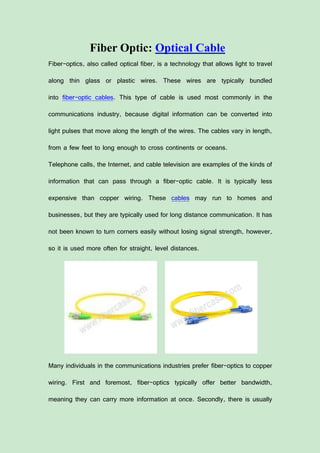Fiber optic cable
- 1. Fiber Optic: Optical Cable Fiber-optics, also called optical fiber, is a technology that allows light to travel along thin glass or plastic wires. These wires are typically bundled into fiber-optic cables. This type of cable is used most commonly in the communications industry, because digital information can be converted into light pulses that move along the length of the wires. The cables vary in length, from a few feet to long enough to cross continents or oceans. Telephone calls, the Internet, and cable television are examples of the kinds of information that can pass through a fiber-optic cable. It is typically less expensive than copper wiring. These cables may run to homes and businesses, but they are typically used for long distance communication. It has not been known to turn corners easily without losing signal strength, however, so it is used more often for straight, level distances. Many individuals in the communications industries prefer fiber-optics to copper wiring. First and foremost, fiber-optics typically offer better bandwidth, meaning they can carry more information at once. Secondly, there is usually
- 2. less attenuation, or signal degradation, in a fiber-optic cable. Thirdly, whereas copper wires use electrical signals, fibers use light waves, so there is less chance of interference in the signal. Lastly, optical fiber wires are made of glass, so there is little risk of fire. A fiber-optic cable is made up of many fiber-optic wires all bundled together. The major component in each wire is the optical glass or plastic core. This core is a thread of clear material that must be as pure as possible in order to conduct light over long distances. Impurities in the core may cause a degradation in the signal. Any fiber-optic cable uses a process called total internal reflection to transmit information down its bundled wires. This particular type of reflection occurs when light hits a clear surface at a precise angle and bounces back instead of penetrating it. An example of total internal reflection occurring in nature can be seen when a swimmer is just barely underwater and he or she can see the ocean floor reflected in the under surface of the water. This reflection occurs due to the angle of the swimmer in relation to the waterâs surface. The light pulse within a fiber-optic cable hits the outer walls of the wire at a similar angle, which keeps the light wave moving forward. The outer surface of the glass wire provides just the right angle of reflection to keep the light bouncing back and forth along the length of cable. The core is encased in cladding, which is an optically-reflective material that aids in this process. Light signals typically enter the fiber-optic cable at one end and are received
- 3. at the other. The signals are usually converted from digital or voice information by a computer. They are then emitted into the cable in the form of light pulses made by a laser or a light-emitting diode (LED) through a lens. An optical cable connector is an important part of optical cable.It is the terminal at the end of a cable that is made of fiber optic strands and that carries digital signals. For most consumers, the most prevalent optical cable connector is the small TOS link plug that typically carries digital audio signals in home stereo and theater systems. Other optical cable connector standards apply in the networking field, in which optical fiber cables provide extremely high bandwidth connections. Digital audio cables typically feature the TOS link optical cable connector. This connector dates to 1983, when it was developed to carry digital audio signals from compact disc players to outboard digital-to-analog converters and is used today with a range of audio and video devices that output digital audio signals. TOS link optical cable connectors are relatively small and easy to insert because they can be inserted only at the correct angle and click in place when they are properly connected. Their key benefit over wire-based connections is that, because they carry light pulses instead of an electrical signal, they are not subject to electrical interference from other cables. Many home theater systems use the high-definition multimedia interface (HDMI) cable, which combines video and audio signals over a single connection. This can be problematic because HDMI cables can combine many
- 4. different signals into a physically small cable with a relatively small connector, carrying a risk of signal degradation over long runs. For this reason, a combination of optical fiber cables for audio and digital television cables for video signals can provide better performance over long distances. Although the exact distance at which HDMI cables become unsuitable varies, a good rule of thumb is for a consumer to look for an alternative to HDMI if a cable needs to be more than 50 feet (15.2 m) in length. Computer networking applications also use fiber optic cables because of their ability to carry extremely high bandwidths of data and to span long distances. Over the years, many optical cable connector standards have emerged, with newer connectors typically being much smaller than older connector standards. As with the TOS link optical cable connector, optical networking cables typically encase the fiber in a protective ferrule to protect it from damage and to help it to line up with either light receivers or additional optical cables. Most of the time, individual computer users will not use optical cables for their networking, because fiber connections typically connect entire campuses or
- 5. offices to the larger public network. View:www.fibercasa.com for more information





